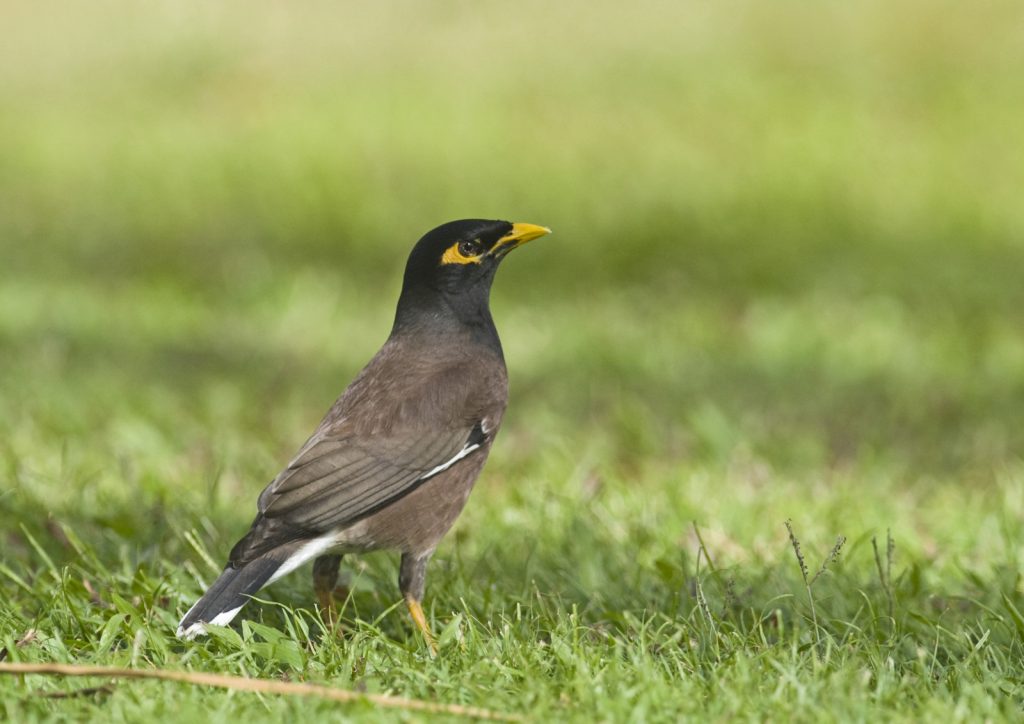One of the world’s worst invasive species, the pesky Indian myna, has rapidly infiltrated the Kruger National Park over the past 20 years, worrying conservationists.
The bird, also known as the common myna, is native to south-east Asia, but established as an alien globally, including in South Africa, where it is invasive, explained Dr Llewellyn Foxcroft, a SANParks scientist at the Kruger and a core team member of the Centre for Invasion Biology at Stellenbosch University.
The aerial invaders have a strong preference for urban areas and usually do not expand into natural areas, he said.
“The mynas have been spreading eastwards through the country, resulting in the populations building up in increasing numbers in our neighbouring towns. These towns have provided ideal habitat, as in all the cities/towns where they have invaded. However, as their numbers started building up outside the boundaries, they started spreading into tourist camps and staff villages in the park.”
The number of mynas has grown dramatically over the last few years. They are known to be fairly aggressive species and seem to be in an initial phase of setting up. The major concern is that they are damaging to other bird species but, given the vastness and complexities of the Kruger, there is still some uncertainty about how big an impact they will have.
First sightings in 2000
Sightings of the Indian mynas first started 22 years ago in the Kruger, although they had been building up in number on the outside of the park for a few years.
According to Foxcroft, the chances of the mynas around the Kruger invading it were slim. The Kruger has an area of about 2-million hectares and a human footprint of less than 1% of its area.
In 2010, there were only eight sightings of Indian mynas in the Kruger, with a total of 14 birds recorded. But by 2020, more than 60 unique observations — those made in a given location within the Kruger for the first time — had been reported, Foxcroft said. This showed that the rate of spread has recently dramatically increased, with the past three years accounting for 66% of the total number of 128 sightings. The number has reached nearly 300 Indian mynas in total.
A study by Foxcroft and colleagues at the Charles University in Prague and the Czech Academy of Sciences suggests that the common myna is in the initial phase of establishment at the Kruger. Thirty-two birds were observed to be nesting or breeding.
Aggressive
“In the Kruger, some of the concerns include the aggressive competition with other birds for nesting sites and potentially feeding on eggs and the young of other birds … They have also been observed taking nesting material from other birds’ nests or taking over native birds nests, for example, red-billed buffalo weaver at Stapelkop Dam.”
While it appears some mynas have established themselves in the Kruger, it is “quite difficult to tell numbers exactly”, he said.
“It also appears that some of the birds move into the park in summer and out in winter, so I am not sure if they are permanent residents or spend part of the year in the park, but we have not tested this scientifically.”
World’s worst invasive species
The IUCN has declared Indian mynas among the world’s 100 worst invasive species.
Foxcroft said it was unlikely the mynas would severely impact local birds because the Kruger is so large and so diverse but the species is scored as having a “moderate impact” in the Environmental Impact Classification for Alien Taxa IUCN scheme. This is the global standard for measuring the severity of environmental impacts caused by animals, fungi and plants living outside their natural range.
Preventing a large-scale invasion
“With the lag phase of only a decade and significant increase thereafter, the question is whether there is still enough time to prevent a large-scale invasion across the park,” said Klára Pyšková, a PhD student at Charles University.
“The apparent ease with which common mynas appear to adapt to the Kruger’s habitat, suggests that these trends will continue if not managed. However, with the large number of populations on the Kruger’s more than 400km western and southern boundary, any response is likely to be complex,” Pyšková said.
Foxcroft said the aim was to discourage them from establishing nesting sites — “so removing the nests as soon as the mynas start showing signs of building them or setting up structures to prevent access to sites that are typically favoured”.
He added that in the SANParks estate, in addition to the Kruger, Indian mynas had been recorded in Mapungubwe, Golden Gate Highlands and Marakele national parks.
Another invader of concern for the Kruger is the rose-ringed parakeet. “There are some scientists that suggest the impact could be much more severe than the myna,” said Foxcroft. Invasives South Africa lists them as very noisy, potentially damaging to agriculture, competing for nest sites with local birds and carrying diseases that could be harmful to poultry, native fauna and humans.
“There are reports from the Hazyview area (outside the park), and also an observation reported from the Lower Sabie region, however, these birds were not seen again, so it is possible they moved back out of the park.”



